Power from inside the Earth’s crust has molded California’s Lassen Volcanic National Park into an active landscape that continues to transform today. From erupting geysers to bubbling mud pots, the park is a living example of vulcanism and the considerable strength it has to alter the planet and move land masses. The Earth’s tectonic plates are locked in an ongoing battle in northern California, where four distinct types of volcanoes are in full view to park visitors.
The park is also home to jagged peaks, scenic waterfalls, and alpine meadows full of wildflowers that bloom in the spring and flourish all summer long. Winter brings its own treasures, as adventurous travelers on snowshoes will discover. Hiking past boiling lakes billowing with steam while surrounded by fresh snow is a surreal experience for the winter explorer. No matter the season, this wild and tumultuous land will entice visitors with surprises around every corner.
Why Visit Lassen Volcanic National Park in Your RV?
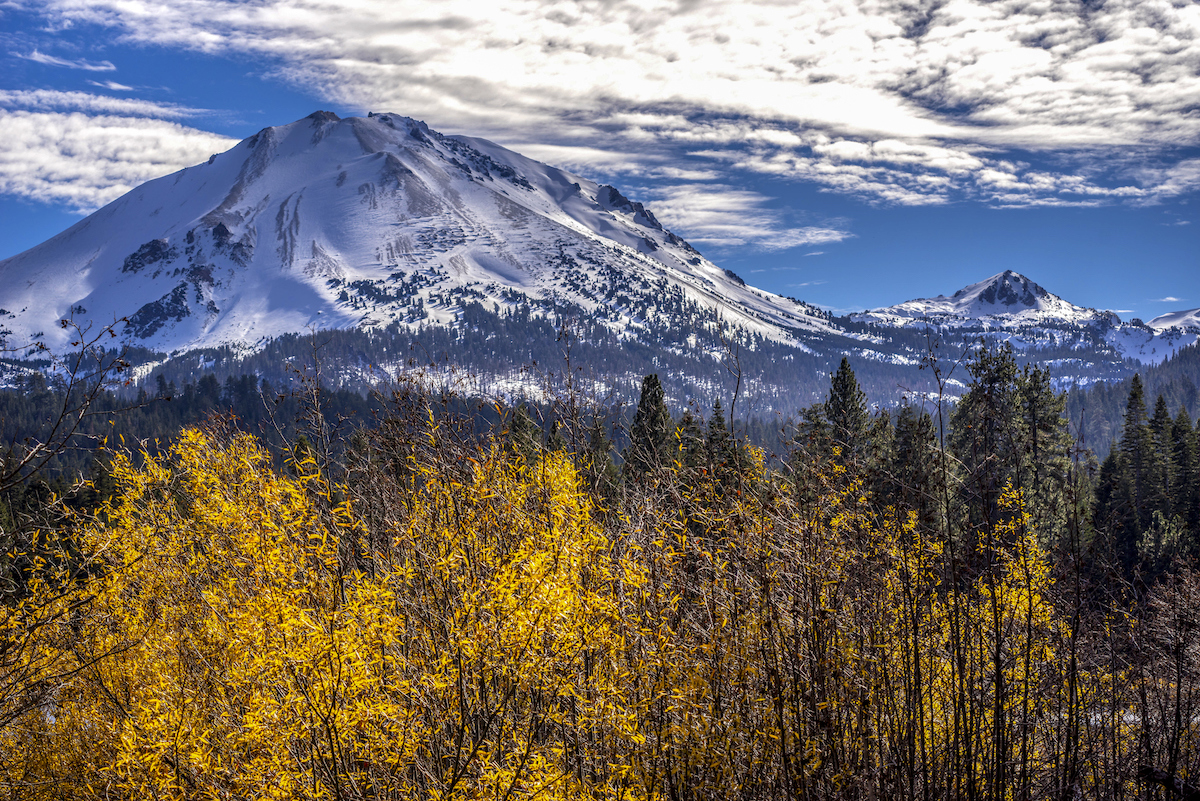
Photo Credit: MBRubin/Getty
Northern California has a lot to offer visiting RVers, and Lassen Volcanic National Park is one of the region’s best features. In addition to its stunning and dramatic landscapes, Lassen has five campgrounds that provide space for motorhomes and trailers. Additionally, the north and south entrances are paved for easy access, and the Manzanita Lake Camper Store caters specifically to the needs of RVers and tent campers. These amenities make exploring the park’s geothermal features and hiking to its mountain lakes and waterfalls more enjoyable. Especially when you can return home to your “mobile cabin in the woods” for a good night’s rest at the end of the day.
When to Visit Lassen Volcanic National Park
The park is open year-round, but some roads are closed in the winter due to snowfall. The spring and fall shoulder seasons are a good time to go, as crowds are minimal and the weather remains quite good. Here’s what to expect during each season:
Lassen Volcanic National Park in Spring
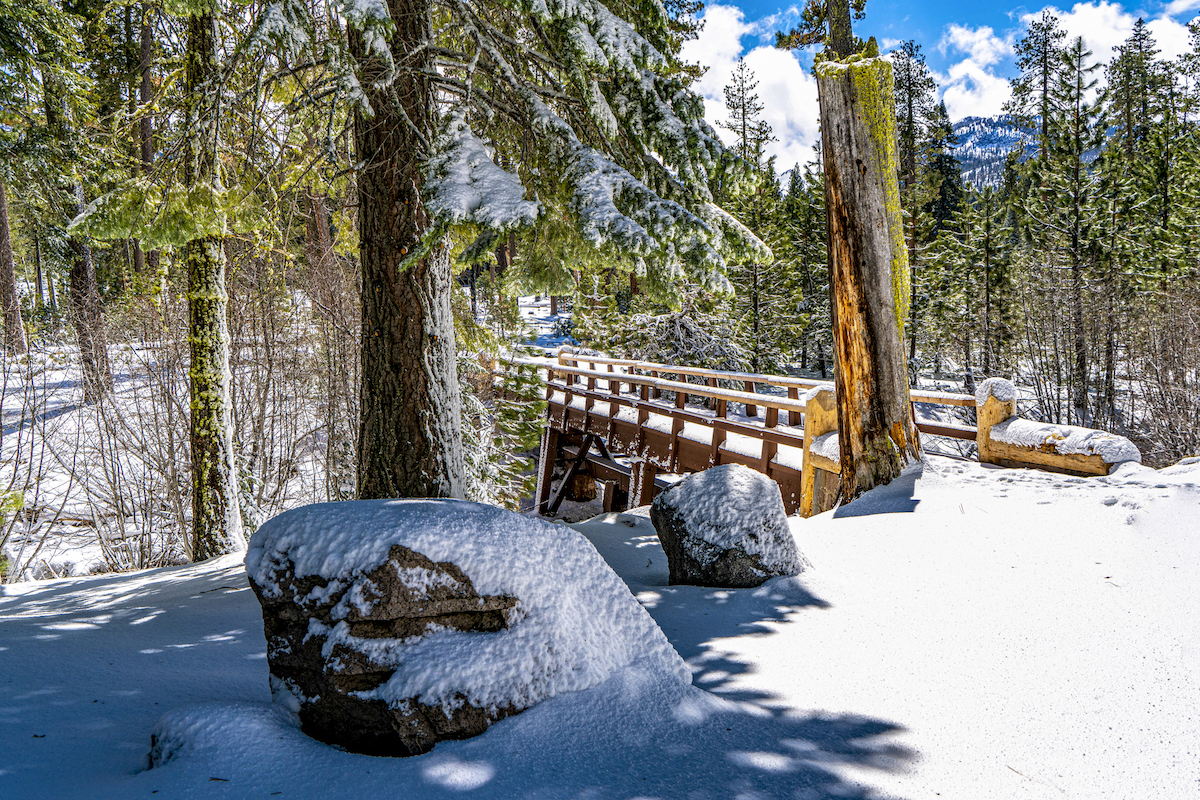
Photo Credit: MBRubin/Getty
Spring brings warming temperatures and slow but steady snowmelt to Lassen Volcanic National Park. Still, it can take some time for the snow to disappear altogether, and it is not unusual for some sections of the park to remain closed into June. Daytime highs average around 70ºF, with overnight lows falling into the 30s. But the weather can be unpredictable, with snow showers occurring on a regular basis. Before going to the park, check the website for updates on current conditions.
Lassen Volcanic National Park in Summer
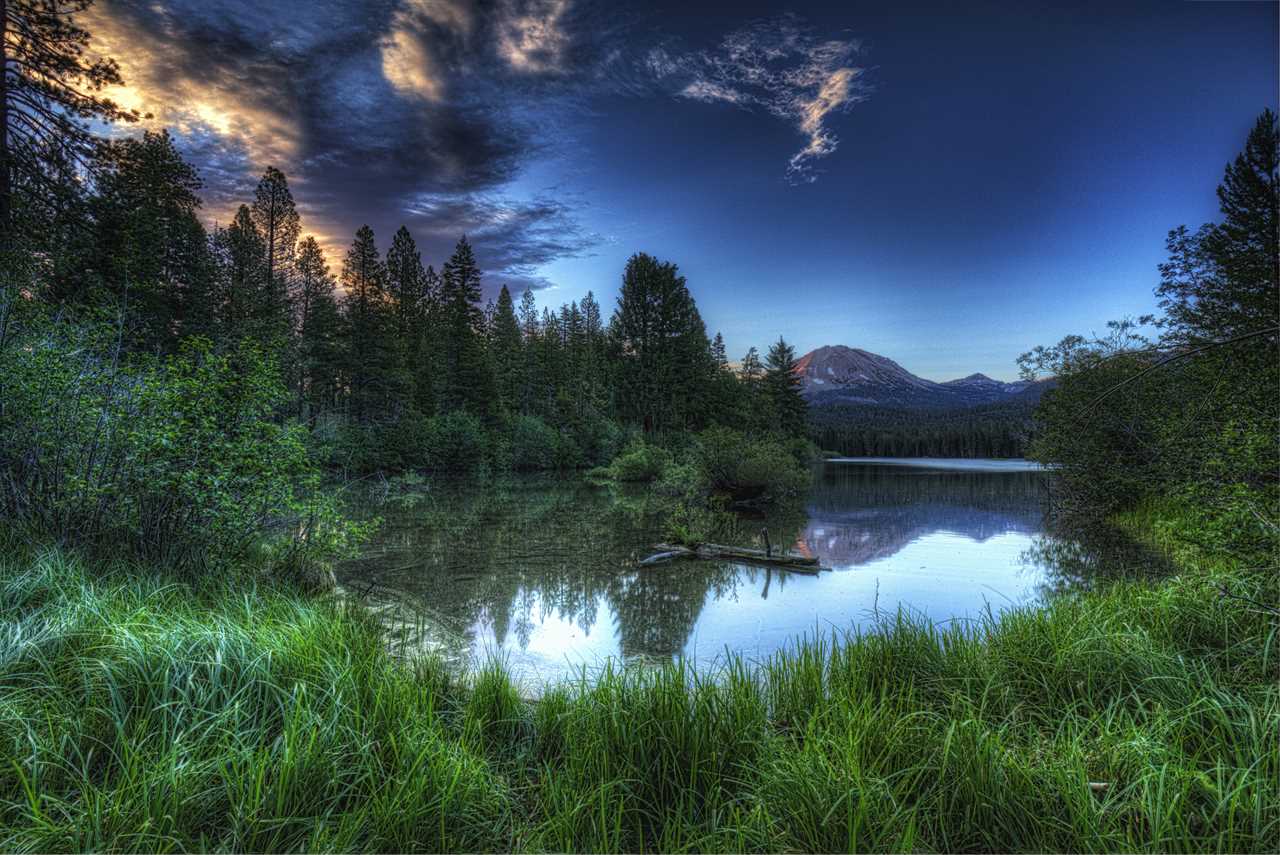
Photo Credit: BurneyImageCreator/Getty
Summer brings the warmest and most stable weather conditions to the park. Average temperatures climb into the mid-80s during the day but continue to be chilly at night, often dropping into the 40s. Most days have clear skies and plenty of sunshine, although an afternoon thunderstorm can occur from time to time. This is the busiest time of year for visitors, so expect more people on the trails and at the park’s visitor centers, stores, and campgrounds.
Lassen Volcanic National Park in Fall
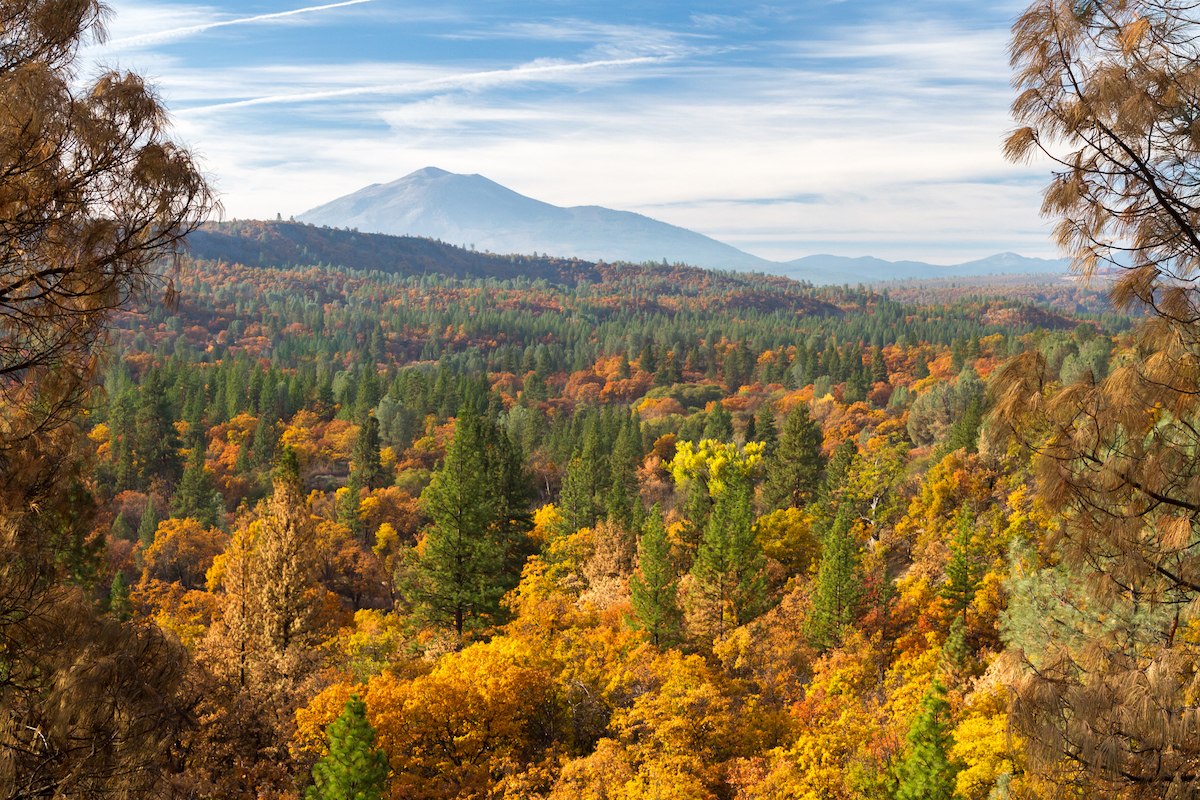
Photo Credit: s_gibson/Getty
Fall is a wonderful time to visit Lassen, as most of the park remains open into November, with just an occasional snowshower occurring at higher altitudes. Early in the season, the days remain warm, with average temperatures falling in the low- to mid-60s during the day and the low-30s at night. Things get considerably chillier as autumn continues, however, so be sure to bring a warm jacket and dress in layers. Crowds tend to trickle off during the fall, although the park can be quite busy on weekends in mid-to-late October, as visitors return in numbers to witness the spectacular colors of autumn leaves.
Lassen Volcanic National Park in Winter

Photo Credit: MBRubin/Getty
Winter is the quietest season in Lassen Volcanic National Park, with far fewer visitors than during the warmer months. The park receives an average of 30 feet of snow each year, which closes off some roads, facilities, and campgrounds. Snowstorms lasting for one to three days are not uncommon, although there are plenty of days when the sky is clear, and the sun is shining. The average temperature at lower elevations is around 55ºF during the day and 25ºF at night. Those temperatures drop about 5ºF for every 1000 feet of elevation gain, so keep that in mind when visiting. Dress in warm layers and bring proper attire for any outdoor activities.
Where to Stay
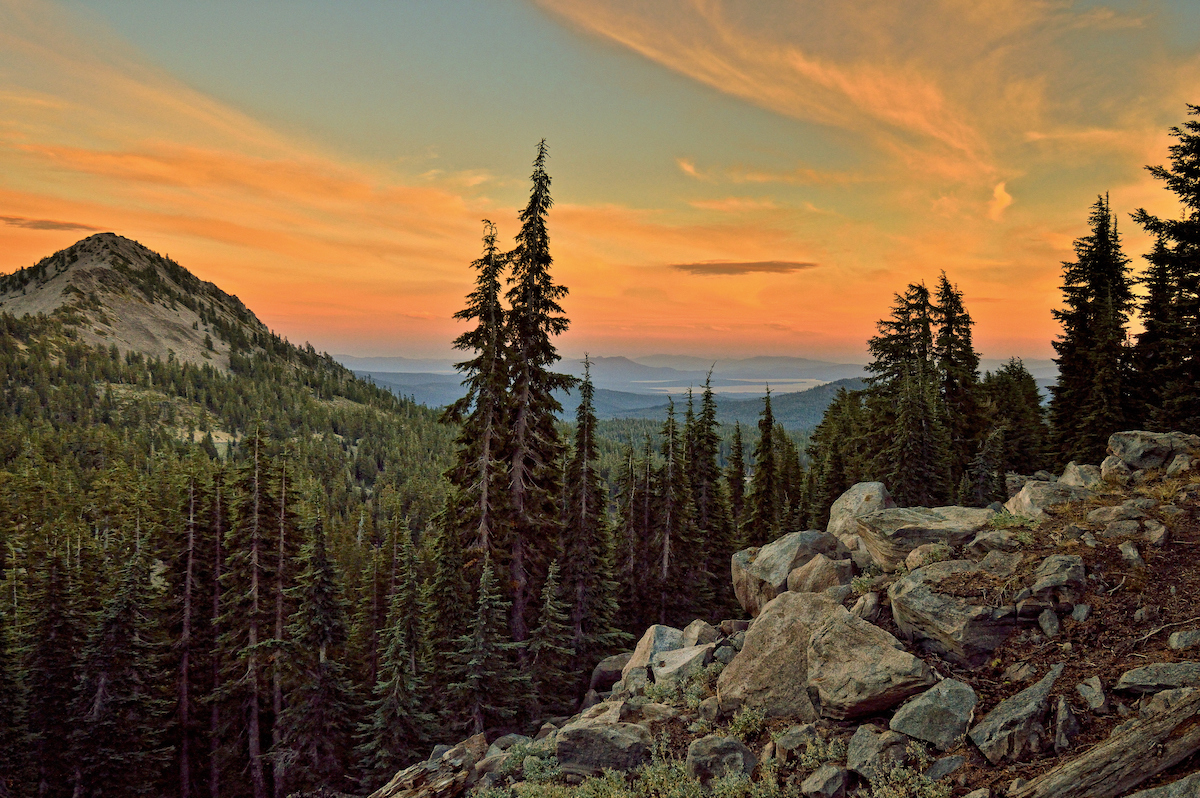
Photo Credit: MBRubin/Getty
Lassen has seven campgrounds in total, although only the Southwest Walk-in site is open year-round. That location is also not accessible by RV, which means if you want to stay in the park from late fall to late spring, you’ll need to do so in a tent.
The park’s other campsites open in late spring and close for the year around mid-October. Reservations are highly recommended from July through September and can be made at recration.gov. Visitors can’t make reservations onsite, so be sure to book your campsite before arrival. Visitors are permitted to camp within the park for up to 14 days per year.
While there are six campgrounds in the park that are accessible by vehicle, the National Park Service recommends that RVers only stay at three of those locations. These include the following:
- Manzanita Lake Campground: No hookups, but the site has a camp store, coin-operated showers, toilets, a laundromat, and kayak rentals. There are 179 individual campsites and 20 camping cabins.
- Butte Lake Campground: A beautiful and remote location, this campground has fewer amenities than Manzanita Lake. RVers will find toilets and bear-proof storage options, but little else. This location has 101 campsites.
- Summit Lake North Campground: RVers staying at the Summit Lake Campground will need to park their rigs at the North site. There isn’t much in the way of amenities here, but the 94 individual campsites are located close to some of the best hiking and kayaking found anywhere in the park.
Staying Outside the Park

Photo Credit: Redding Premier RV Park
If the campgrounds inside the park are booked, or you prefer to stay at a place with more amenities, there are a few options located nearby. Those include:
- Hat Creek Resort & RV Park: Located eleven miles from the park, this campground has everything from cottages and yurts to RV and tent sites with full amenities. These include WiFi, restrooms and showers, laundry services, a snack bar, and groceries.
- Hat Creek Hereford Ranch RV Park & Campground: This RV campground is located 25 miles from Lassen Volcanic National Park and features 53 campsites. It offers full hookups, WiFi, showers, restrooms, and a self-service RV washing station.
- Lassen RV Resort: This campground is located about an hour away from the park, but it is an outstanding site with first-class facilities. It has 44 RV sites with full hookups, internet service, restrooms, showers, laundry, and more.
- The Village at Childs Meadow: Found in Mill Creek, CA this campground is located just a half-hour away from the national park. It features 26 RV campsites, WiFi, restrooms, showers, and laundry facilities.
- Redding Premier RV Resort: Located an hour away from the national park, this campground is one of the best in the region. It has 104 RV campsites, full hookups, a swimming pool, games, and everything else you would want for your visit.
- Mountain Gate RV Park: Another outstanding campground that is within an hour of Lassen. This site offers 108 campsites, full hookups, WiFi, a dog park, showers, restrooms, laundry, and more.
Invest in a Good Sam Membership and save 10% on nightly stays at Good Sam Campgrounds.
Tips for Your Camping Stay
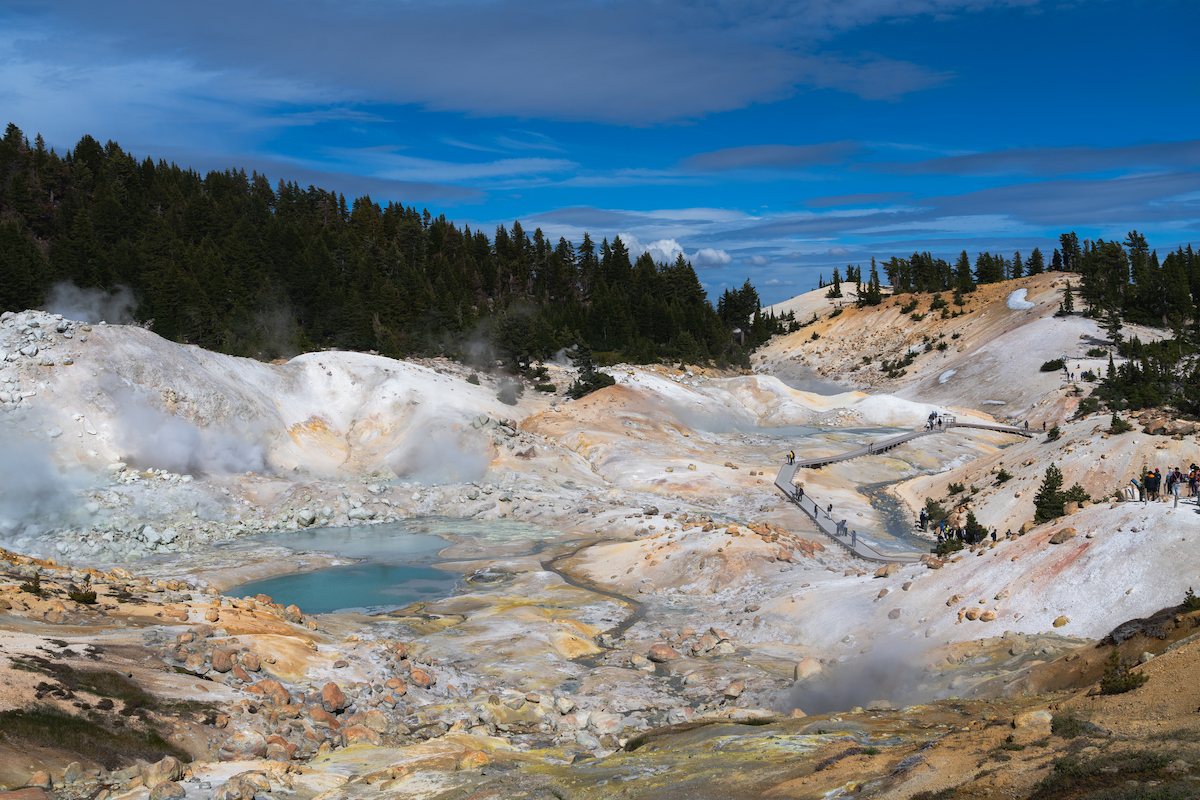
Photo Credit: JINCHAO LYU/Getty
- Reservations for Lassen’s three RV campgrounds can be made up to six months in advance.
- To reserve your site, visit recration.gov or call 1-877-444-6777
- There may be a fire ban inside the park during the summer months. Check the website or look for posted signs on arrival for the latest rules on campfires. If permitted, wood may be gathered from within 30 feet of the road, and logs must be no larger than 4 inches in diameter.
- Quiet hours run from 10:00 PM to 6:00 AM each day and generator use is restricted to 8:00 AM to 10:00 AM, 12:00 PM to 2:00 PM, and 5:00 PM to 7:00 PM.
- Sleeping in vehicles and boondocking are not allowed.
- Dispersed backcountry camping is allowed within the park, but all backpackers must have a permit.
- Campsites are limited to three tents, six people, and two vehicles, including an RV or trailer.
- Group sites require a minimum of 10 people, but are limited to no more than 25 people and six vehicles.
- All food must be stored in a bear-proof container. All campsites have storage lockers available onsite.
- Pets are welcome at the park’s campsites but must remain on a leash no longer than six feet at all times.
Getting To and Around Lassen Volcanic National Park
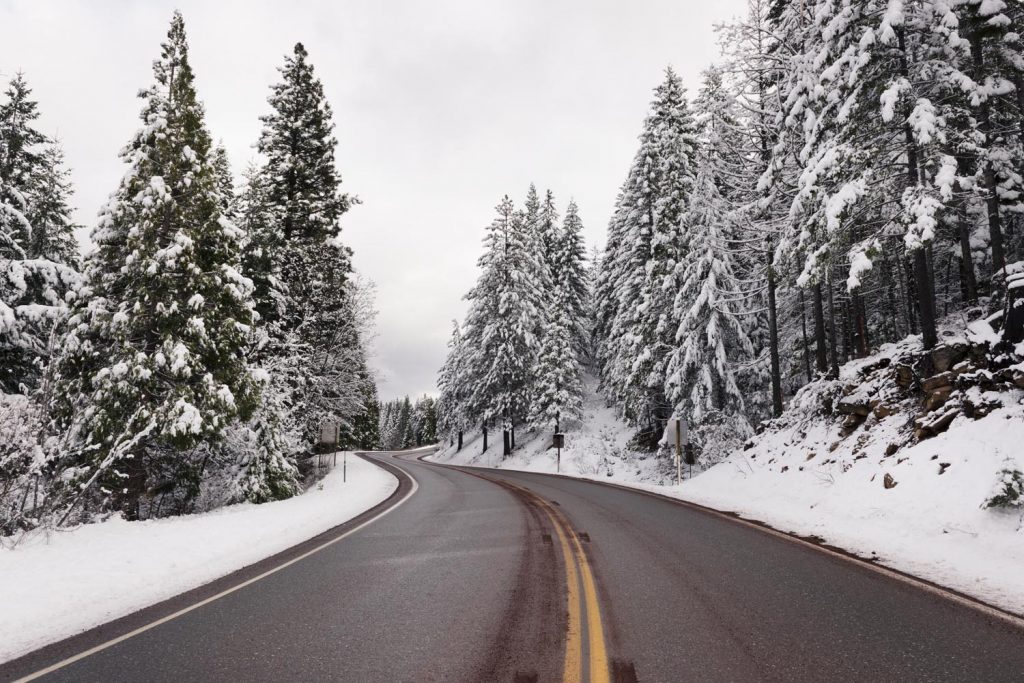
Located directly east of Redding and northeast of Chino, California, Lassen has five distinctive entrances. The two paved highways that lead to the park are Highway 44 in the north and Highway 36 in the south. The other three roads are dirt and dead end at the southeast (Warner Valley and Juniper Lake roads) and northeast (Butte Lake Road) corners of the park.
Once in the national park, the Lassen Volcanic Park Highway is a 30-mile paved road connecting the north and south sections of the park. All roads close for the winter season (usually December through May), but vehicles can get to the visitor center in the south and Loomis Plaza in the north year-round.
Places to Go
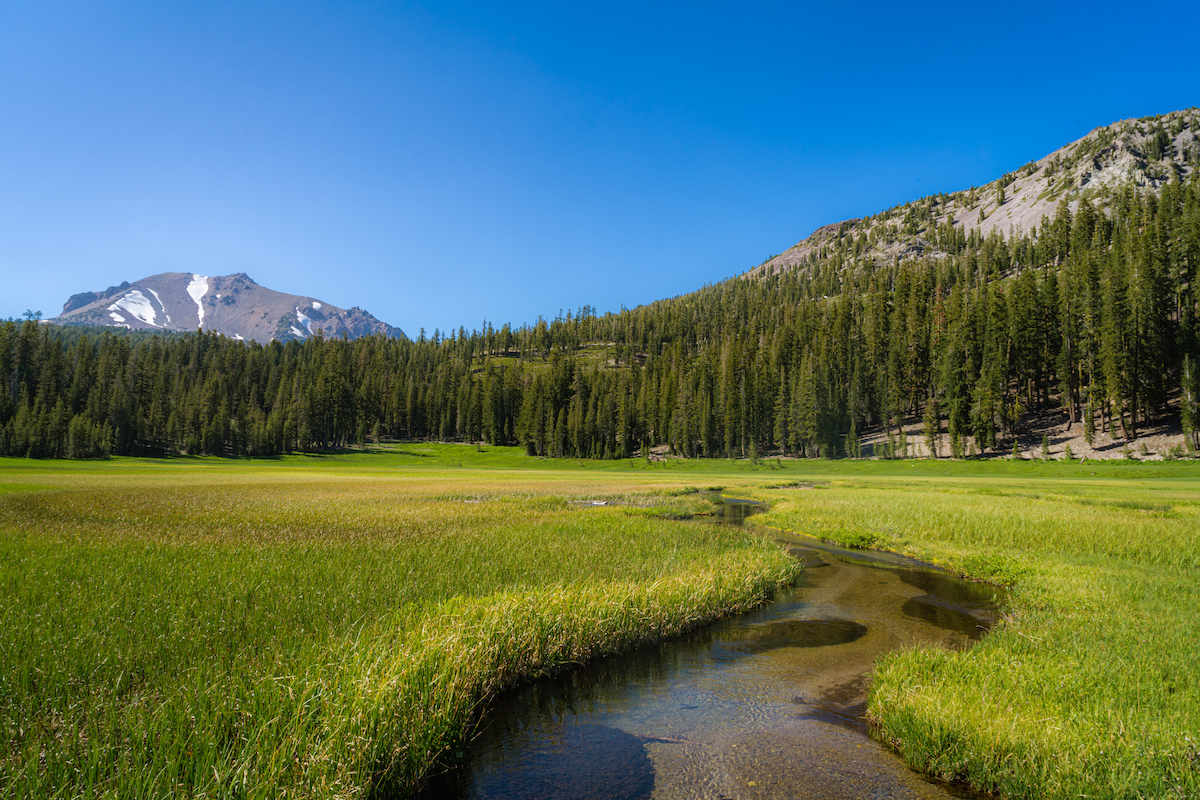
Photo Credit: Pedro Freithas/Getty
Lassen Volcanic National Park is over 106,000 acres in size, so naturally, there is a lot to see and do there. During your visit, these are some of the must-locations to have on your radar:
Kohm Yah-mah-nee Visitor Center
This visitor center is located a mile inside the Southwest Entrance and is open year-round. It features displays and exhibits of Lassen’s volcanic past, as well as a film that touches on the park’s history and geology. There is a bookstore, café, and gift shop inside, along with a diner and a fireplace patio. Visitors can access free WiFi at this location too.
Loomis Museum
Located one mile from the park’s Northwest Entrance—and not far from Manzanita Lake—this museum hosts artifacts and photos from B.F. Loomis. He is the last person to document an eruption of Lassen Peak and was a staunch supporter of the park. Ranger-led tours start here, and a theater and bookstore are also on site.
Manzanita Lake Area
The most developed and accessible of the park’s different regions is the Manzanita Lake Area. This is a popular destination for campers and hikers, thanks in part to its proximity to campgrounds, a visitor center, a store, and other park facilities. Most of the trails found in this region are easy to moderately difficult, making it a great place to stretch your legs. Be warned though, this area is very popular and can get quite crowded during the busy months.
Southwest Area
If you’re looking for someplace that is a bit more wild and more remote, travel to Lassen’s Southwest Area. Here, the terrain is steeper and more challenging, making the hiking trails more difficult too. The region isn’t without its modern amenities, however, as there is a year-round visitor center and campground found here.
Juniper Lake
While the crystal-clear waters of Juniper Lake can be on the chilly side in the early summer, it is a fantastic location for swimming, kayaking, and stand-up paddleboarding. The lake is found at the end of a dirt road and features a fire lookout on top of Mount Harkness that offers great views of the surrounding area.
Hydrothermal Areas
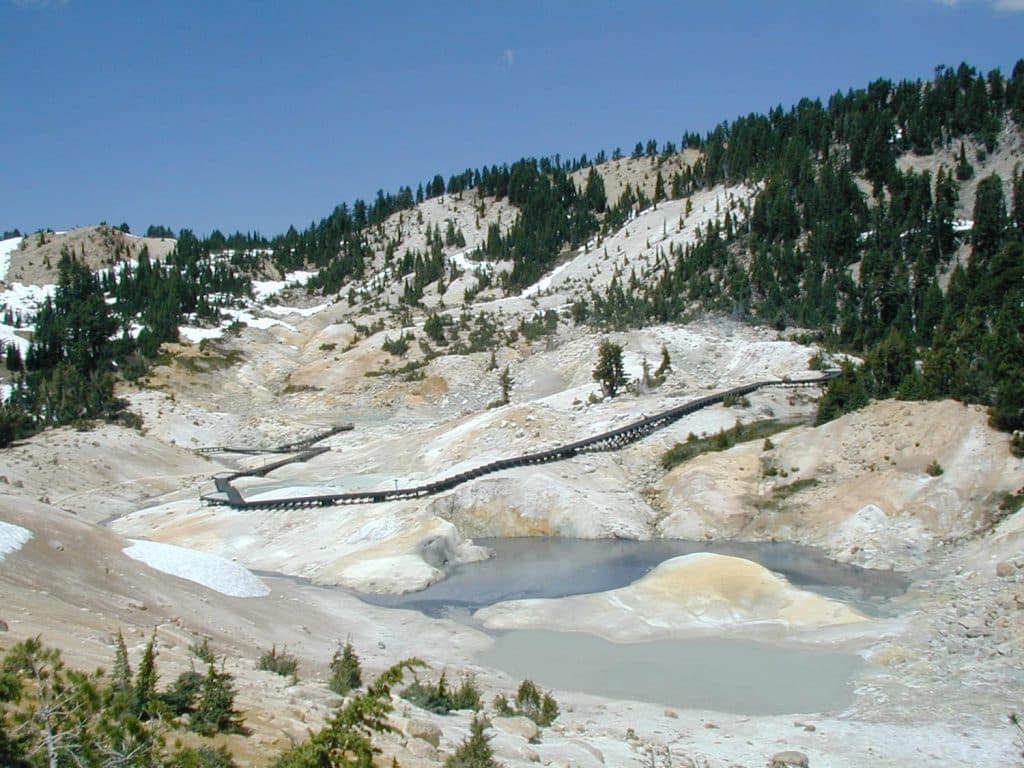
There are eight different areas in the park where its vulcanism is on display, including hot springs, steaming geysers, and boiling mud pots. These formations indicate that further eruptions may occur in the future and are reminders of the powerful forces at work within the park. When visiting, please stay on walkways, as injuries have occurred to those who venture out of bounds.
Here are the 8 regions:
- Bumpass Hell
- Sulphur Works
- Devil’s Kitchen
- Boiling Springs Lake
- Little Hot Springs Valley
- Pilot Pinnacle
- Terminal Geyser
- Cold Boiling Lake
Things to Do
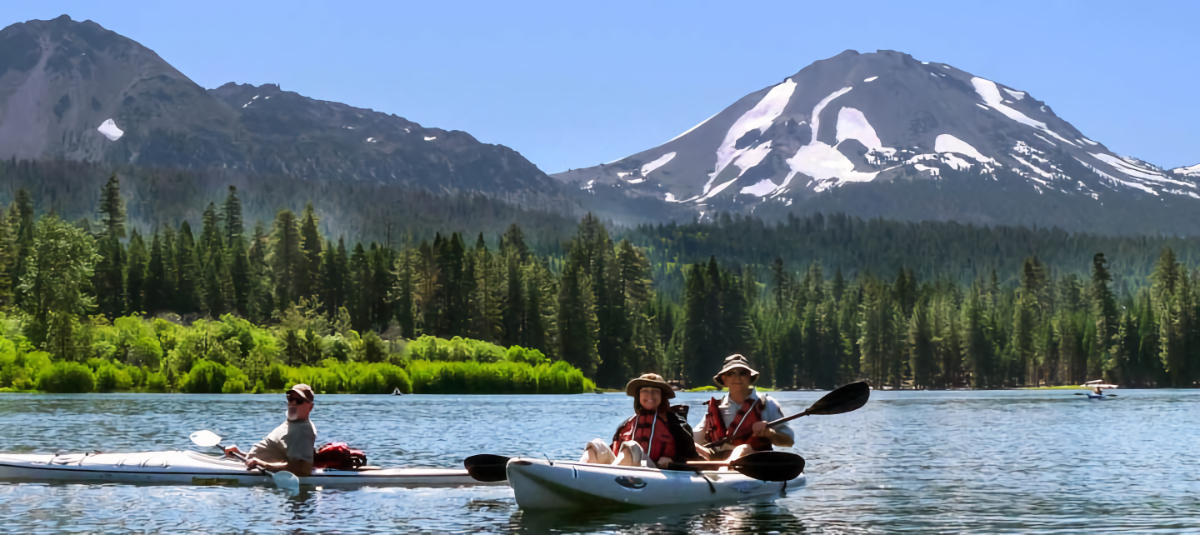
Photo Credit: National Park Service
Outdoor enthusiasts will find plenty to do in the national park. If you’re planning a visit, here are a few options to help keep you active:
Paddling
There are a number of lakes found within the park that allow non-motorized watercraft in the summer. These include Manzanita Lake, Butte Lake, Juniper Lake, and Summit Lake. Canoes, kayaks, and paddle boards can be rented from the Manzanita Lake Camper Store.
Fishing
Brown and rainbow trout are prevalent in bodies of water throughout Lassen Volcanic National Park. A California fishing license is required and on Manzanita Lake, anglers are restricted to catch-and-release using single-hook, barbless, and artificial lures only.
Be advised there are several spots within the park where fishing is not allowed, Anglers should check with a ranger regarding those locations and the best places to cast their line.
Camping
There are seven campgrounds within Lassen Volcanic, three of which have available spots for RVs. There are no hookups, but during the summer months, most campgrounds have water available for use. The Manzanita Lake Campground also has cabins for rent, as well as a dump station. Here is a list of the campgrounds with links to their descriptions:
- Butte Lake Campground
- Volcano Adventure Camp (was Crags Campground)
- Juniper Lake Campground
- Manzanita Lake Campground
- Summit Lake Campground
- Southwest Walk-In Campground
- Warner Valley Campground
Hiking
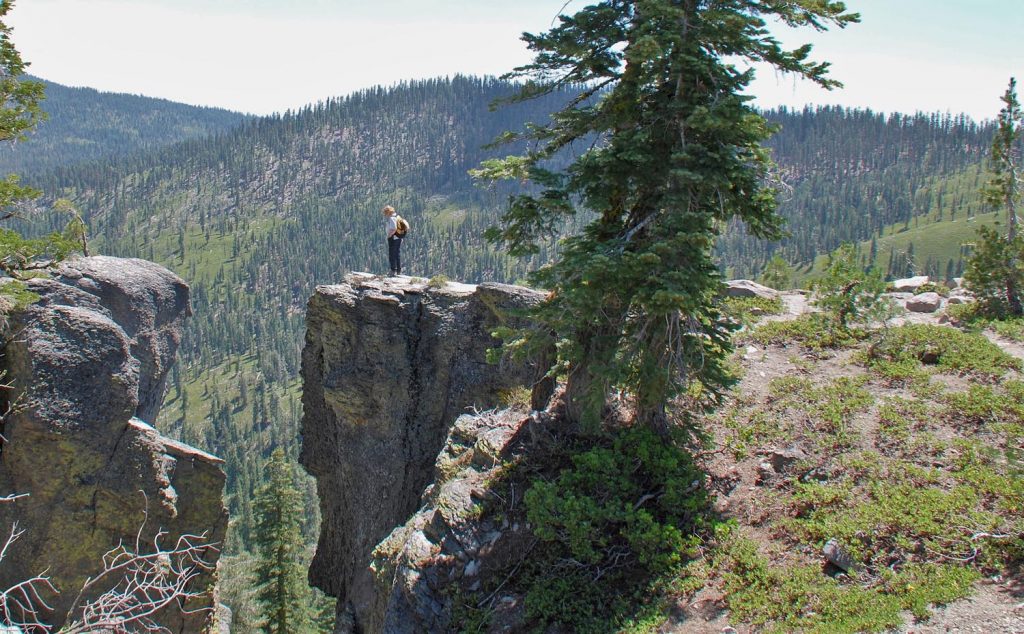
Lassen offers over 150 miles of hiking trails through four different regions in the park. Hikers can witness the devastation of the last eruption while wandering through hydrothermal areas. Visitors can revel in wildflower-filled meadows on many trails or take a hike to the top of Lassen Peak, the highest point in the park at 10,457 feet above sea level.
Hikers and backpackers are reminded to stay on trails at all times, as some ground is just a thin crust over boiling water or other hydrothermal activity.
Auto Touring
The Lassen Volcanic National Park Highway is a 30-mile scenic drive that offers a wonderful overview of the park. Here are some of the highlights where pull-outs are available:
- Sulphur Works
- Bumpass Hell Overlook
- Lassen Peak Viewpoint
- Kings Creek Meadow
- North Summit Lake Picnic Area
- Hat Creek
- Devastated Area
- Chaos Crags and Jumbles
Stargazing

Lassen’s location away from large population centers makes it the perfect stargazing destination. The Starry Nights programs led by park rangers take place at various spots within the park’s borders, and every year a Dark Skies Festival is held the first weekend in August. During the event, visitors can participate in special hikes and presentations by astronomers and astrobiologists and enjoy viewing the night skies through telescopes and a solar scope.
Parkcaching & Earthcaching
Lassen Volcanic National Park allows parkcaching within the park boundaries. Participants need a GPS device and a geocaching app, along with a challenge brochure to locate hidden caches along the park highway.
For those interested in learning more about the geology of the park, earthcaching may be just the ticket. This activity also uses GPS coordinates to help participants locate “earthcaches” hidden across the area. In order to find these secret troves, participants are required answers to questions about the geological and geographical treasures found within the park. Those clues help them to physically locate the cache, making this activity somewhat akin to a scientific version of a scavenger hunt.
Horseback Riding
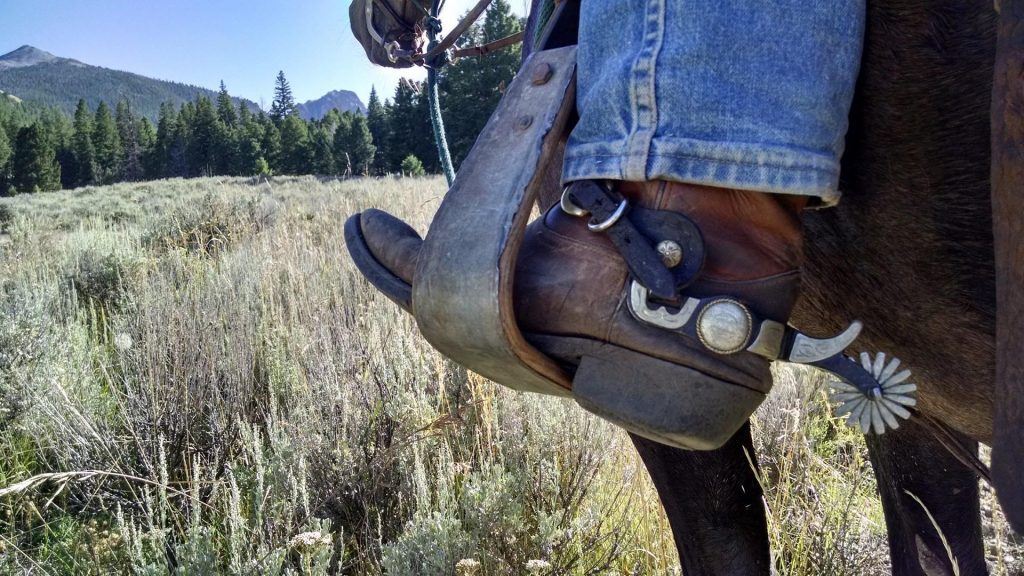
Bring your own horse and ride over 100 miles of trails in the park. Overnight camping with stock is not allowed in the backcountry. However, there are three corrals at Butte Lake, Juniper Lake, and Summit Lake. A permit is required, as are camping reservations near the corrals.
Check here for a list of regulations.
Winter Outdoor Activities
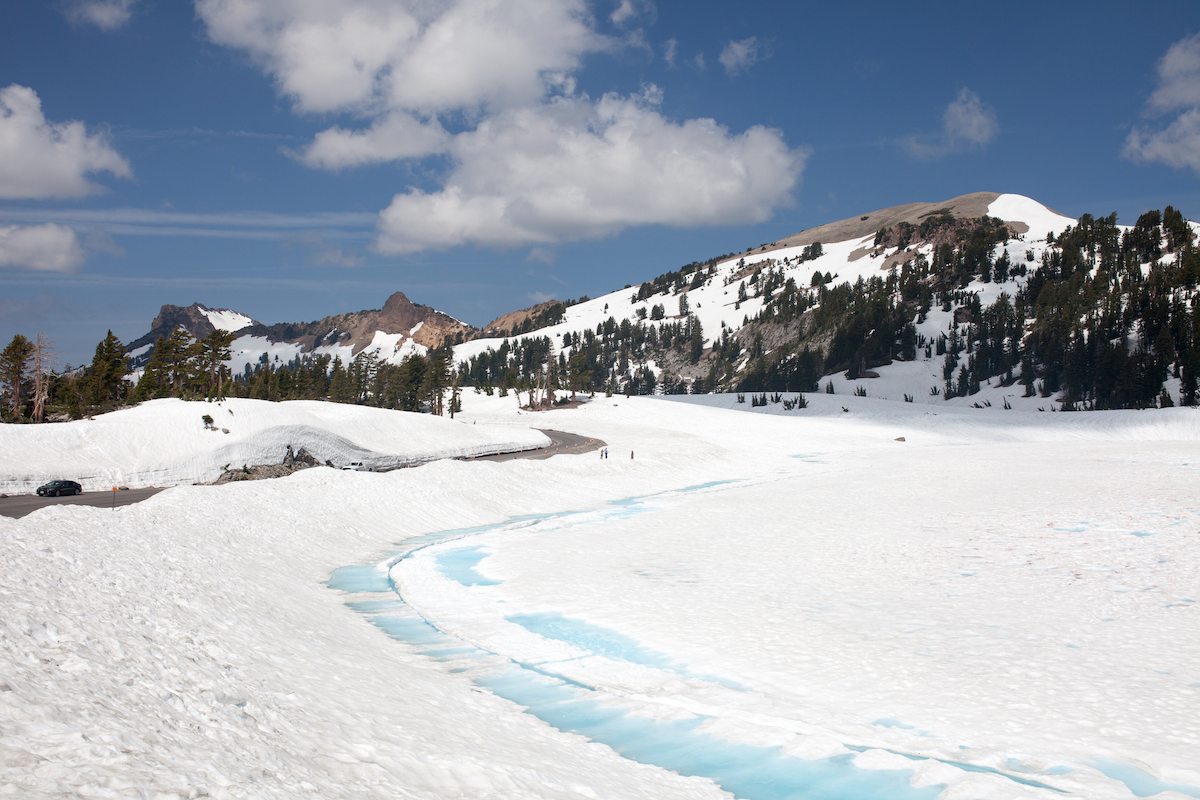
Photo Credit: Mingzhe Zhang/Getty
Despite receiving an average of more than a thousand inches of snow each year, Lassen remains open throughout the winter. That makes the park an excellent destination for snowshoeing, cross-country skiing, or winter camping. Keep in mind, much of the park is inaccessible during the winter due to the snow, but the landscapes are strikingly beautiful. Be sure to dress warm, bring plenty of food and water, and take caution when traveling into the backcountry.
What to Bring and How to Prepare
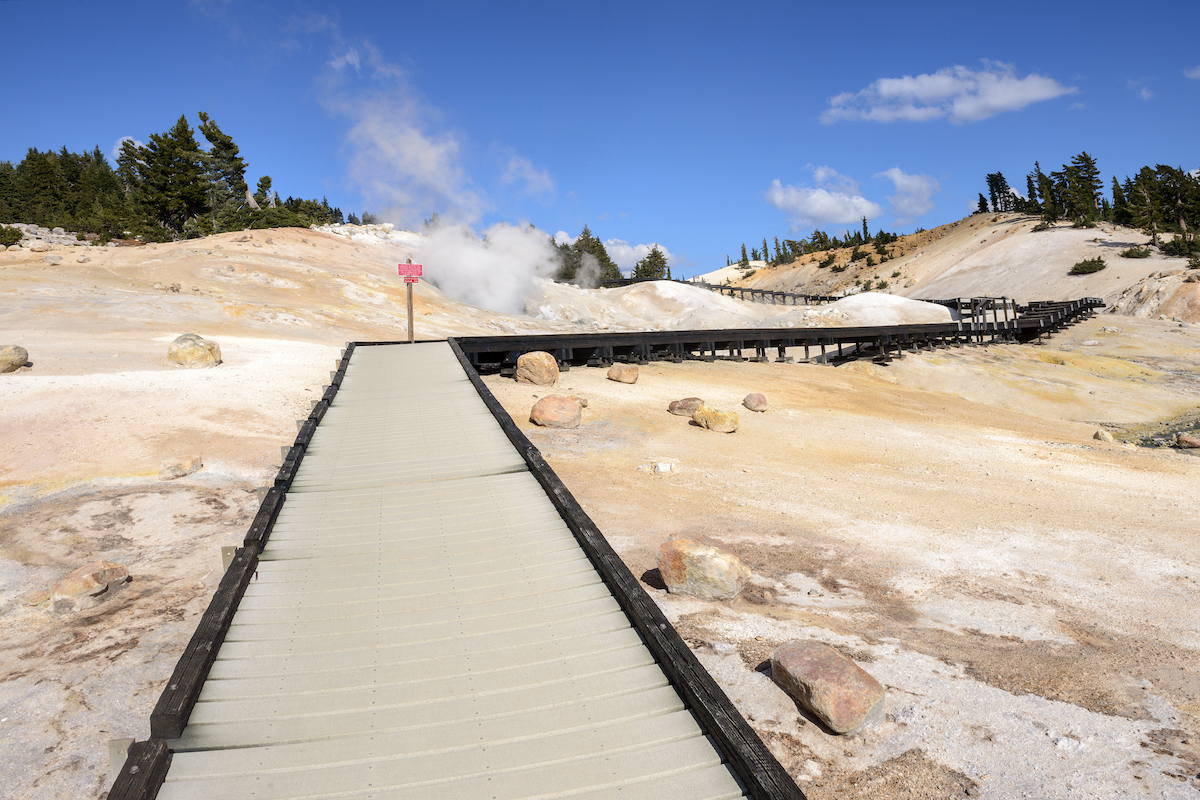
Photo Credit: kojihirano/Getty
- One of the most surprising things for first-time visitors to Lassen Volcanic National Park is the elevation changes found there. The park ranges in height from 5650 feet to 10,457 feet. Those altitudes can catch those who are unprepared by surprise, causing headaches, nausea, and fatigue. Take it slow while undertaking any physical activities.
- The temperature can change dramatically as you travel to higher elevations too. Expect a 5ºF difference for every 1000 feet of altitude gained. Bring a jacket or other additional layers, even when visiting in the summer.
- Due to bears living in the park, no food or beverages should be left outside unattended. Bear-proof lockers are available at all campsites and storing food inside your RV is an option. Keep in mind, some bears are persistent enough to break into vehicles to get a free meal.
- Free WiFi is available at the park’s visitor centers, but internet and cell service are spotty throughout the rest of the park. Adding a cell signal booster to your rig can help alleviate the challenges of staying connected.
- Use a layering system when dressing for outdoor activities, even in the summer. The park’s weather can change quickly at times and temperatures can fluctuate dramatically. By wearing seasonally-appropriate base layers, and having a fleece and/or jacket on hand, you’ll be better prepared for the conditions.
- Heavy snows close park roads starting in late November and into early June. For the latest updates on those conditions—and which sections of Lassen are open or closed—visit the National Park Service website.
History of Lassen Volcanic National Park

Lake Helen by Daniel Schwen (CC BY 2.5)
Native Americans inhabit the space that is now Lassen Volcanic National Park for centuries before European settlers even know it existed. Those indigenous tribes knew that the volcano was a source of fire and water and long feated an eruption. Those eruptions weren’t documented until westward expansion brought European settlers to the area in the early 1800s. Among them was Peter Lassen, from which the park and its famous mountain would get its name.
Because of its volatile nature and geothermal activity, the area surrounding Lassen Peak remained mostly uninhabited. It was recognized for its natural beauty, however, with adventurous travelers and explorers visiting regularly to map out its hidden secrets. By 1907, the park’s stunning beauty was made known to President Theodore Roosevelt, who designated the region as a national forest and proclaimed Lassen Peak and its cinder cone national monuments.
In 1914, Lassen Peak began a series of tumultuous eruptions. For several years, lave routinely flew from the mountain’s summit and flowed down its slopes, creating an unstable environment. This resulted in the creation of a new crater and the spewing of ash, which caused the few people living in the region to evacuate their homes, some of which were completely destroyed. This volcanic activity would continue for years and played an important role in getting the national forest and monuments upgraded to national park status. That happened on August 9, 1916.
Today, Lassen Volcanic National Park sees about 500,000 visitors on an annual basis. Most of those travelers come in August and September each year. Those who make the journey are treated to a breathtakingly beautiful landscape and some of the best displays of geothermal activity found anywhere in the world.
Plan your next trip to the national parks in an RV. Rent an RV, trade-in your RV, or buy a new or used RV and start traveling for less than $5 a day.
Have you ever been to Lassen Volcanic National Park? What were your experiences there?
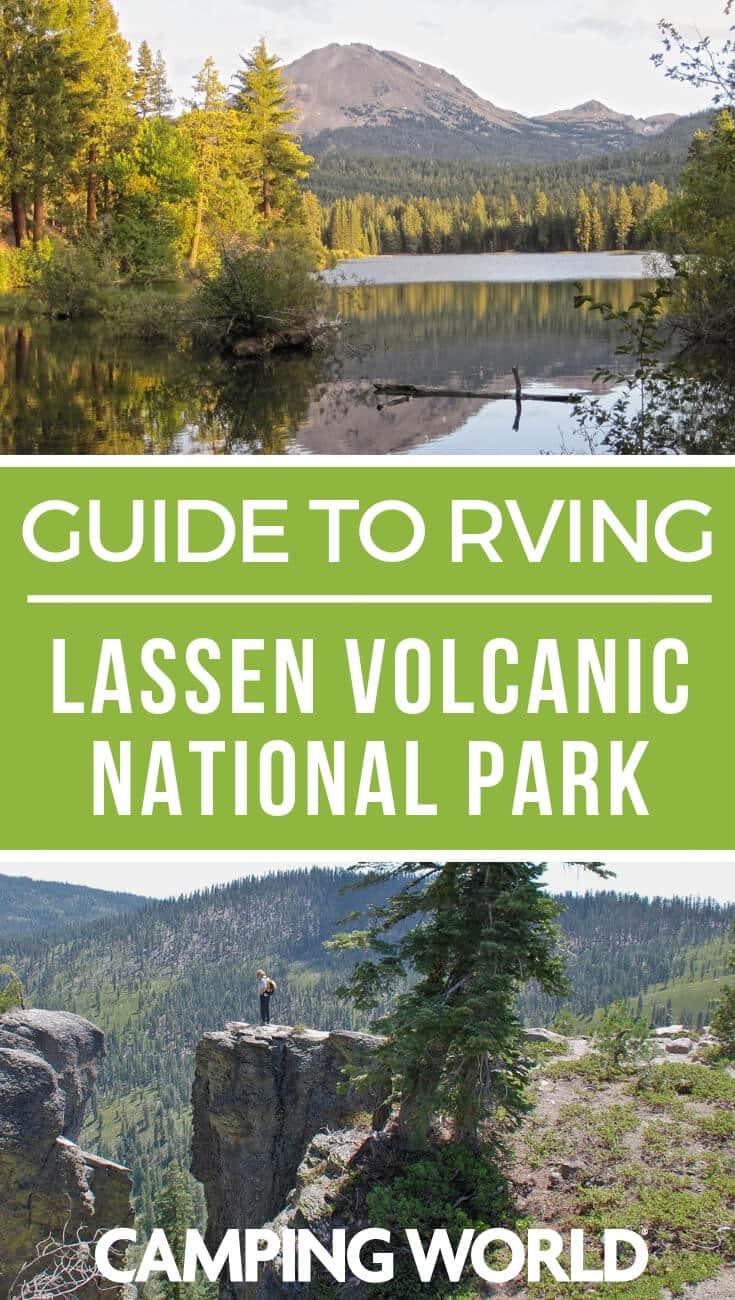
By: Shelley Dennis
Title: Camping World’s Guide to RVing Lassen Volcanic National Park
Sourced From: blog.campingworld.com/the-rv-life/where-to-go/camping-worlds-guide-to-rving-lassen-volcanic-national-park/
Published Date: Wed, 05 Oct 2022 17:00:17 +0000
---------------------------------------------
 CampingSurvivalistHuntingFishingExploringHikingPrivacy PolicyTerms And Conditions
CampingSurvivalistHuntingFishingExploringHikingPrivacy PolicyTerms And Conditions
